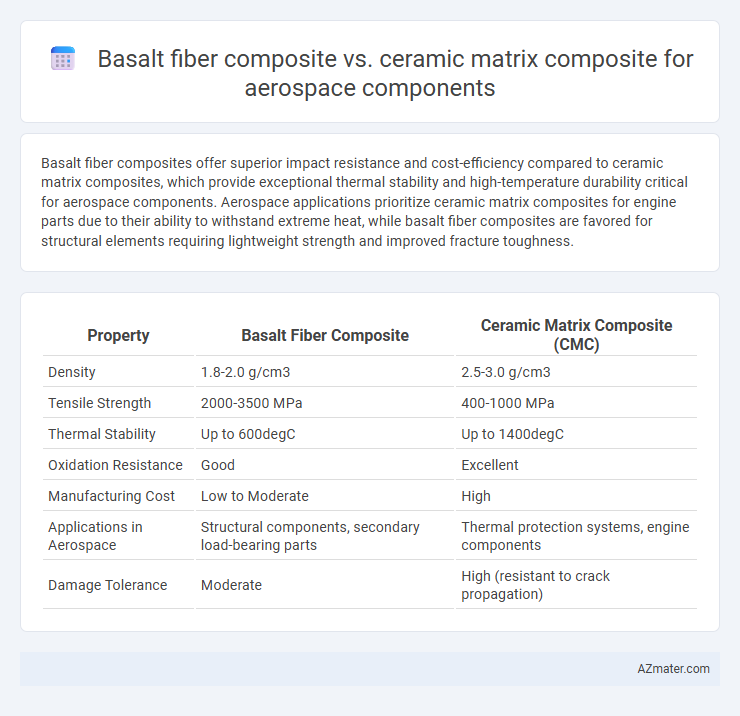Basalt fiber composites offer superior impact resistance and cost-efficiency compared to ceramic matrix composites, which provide exceptional thermal stability and high-temperature durability critical for aerospace components. Aerospace applications prioritize ceramic matrix composites for engine parts due to their ability to withstand extreme heat, while basalt fiber composites are favored for structural elements requiring lightweight strength and improved fracture toughness.
Table of Comparison
| Property | Basalt Fiber Composite | Ceramic Matrix Composite (CMC) |
|---|---|---|
| Density | 1.8-2.0 g/cm3 | 2.5-3.0 g/cm3 |
| Tensile Strength | 2000-3500 MPa | 400-1000 MPa |
| Thermal Stability | Up to 600degC | Up to 1400degC |
| Oxidation Resistance | Good | Excellent |
| Manufacturing Cost | Low to Moderate | High |
| Applications in Aerospace | Structural components, secondary load-bearing parts | Thermal protection systems, engine components |
| Damage Tolerance | Moderate | High (resistant to crack propagation) |
Introduction to Advanced Aerospace Materials
Basalt fiber composites offer exceptional tensile strength and thermal stability, making them suitable for aerospace components exposed to moderate temperatures and mechanical stress. Ceramic matrix composites provide superior high-temperature resistance and wear properties, critical for engine components and thermal protection systems in aerospace applications. Both materials advance aerospace performance by balancing weight reduction, durability, and resistance to extreme environmental conditions.
Overview of Basalt Fiber Composites
Basalt fiber composites feature high tensile strength, excellent thermal resistance, and superior chemical stability, making them suitable for aerospace components exposed to harsh environments. Derived from volcanic basalt rock, these composites offer a sustainable and cost-effective alternative to traditional materials, with enhanced impact resistance and vibration damping properties. Their lightweight nature contributes to improved fuel efficiency and overall performance in aerospace applications compared to conventional ceramics.
Understanding Ceramic Matrix Composites
Ceramic matrix composites (CMCs) in aerospace components offer superior thermal resistance and enhanced mechanical strength compared to basalt fiber composites, making them ideal for high-temperature applications like turbine engines and thermal protection systems. CMCs consist of ceramic fibers embedded in a ceramic matrix, providing exceptional fracture toughness and oxidative stability at temperatures exceeding 1200degC. This advanced material composition results in lightweight, durable aerospace parts that improve fuel efficiency and performance under extreme conditions.
Mechanical Properties Comparison
Basalt fiber composites exhibit high tensile strength and excellent impact resistance, making them suitable for lightweight aerospace components requiring durability and flexibility. Ceramic matrix composites (CMCs) offer superior high-temperature stability, enhanced wear resistance, and exceptional fracture toughness critical for engine parts and thermal protection systems. While basalt fiber composites provide better damage tolerance and lower cost, CMCs deliver unmatched mechanical performance in extreme thermal and oxidative environments of aerospace applications.
Thermal Performance in Aerospace Environments
Basalt fiber composites exhibit superior thermal resistance withstanding temperatures up to 700degC, providing excellent thermal stability and insulation properties in aerospace environments. Ceramic matrix composites (CMCs) offer exceptional thermal performance beyond 1200degC, maintaining structural integrity and oxidation resistance in extreme high-temperature aerospace applications. The choice between basalt fiber composites and CMCs hinges on the specific thermal demands, cost considerations, and required mechanical properties for aerospace components exposed to harsh thermal conditions.
Weight and Density Considerations
Basalt fiber composites offer a lower density of approximately 2.7-2.8 g/cm3 compared to ceramic matrix composites, which typically have densities around 3.5-4.0 g/cm3, making basalt composites advantageous for weight-sensitive aerospace applications. The reduced weight of basalt fiber composites contributes to improved fuel efficiency and payload capacity in aircraft design. However, ceramic matrix composites provide superior thermal resistance and structural integrity at high temperatures, requiring a trade-off decision based on specific aerospace component requirements.
Corrosion and Oxidation Resistance
Basalt fiber composites exhibit excellent corrosion resistance due to their inherent chemical stability and resistance to moisture, making them suitable for aerospace components exposed to harsh environmental conditions. Ceramic matrix composites (CMCs) offer superior oxidation resistance at high temperatures, maintaining structural integrity in aerospace applications involving extreme thermal environments such as jet engines and hypersonic vehicles. The choice between basalt fiber composites and CMCs for aerospace components depends on the specific exposure conditions, with basalt fibers favored for moisture resistance and CMCs for high-temperature oxidation stability.
Manufacturing Methods and Scalability
Basalt fiber composites are primarily manufactured through processes such as pultrusion, filament winding, and resin transfer molding, offering relatively low-cost scalability for aerospace components due to abundant raw material availability and simpler processing techniques. Ceramic matrix composites (CMCs) require advanced manufacturing methods like chemical vapor infiltration, melt infiltration, and hot pressing, which involve higher temperatures and complex equipment, limiting scalability but enabling superior high-temperature performance and durability. The choice between basalt fiber composites and CMCs depends on balancing manufacturing complexity, production volume, and the specific aerospace application's thermal and mechanical requirements.
Cost Efficiency and Lifecycle Analysis
Basalt fiber composites offer significantly lower production costs compared to ceramic matrix composites (CMCs) due to less energy-intensive manufacturing processes and raw material availability, making them a cost-efficient choice for aerospace components. Lifecycle analysis reveals that while basalt composites provide good corrosion resistance and durability, CMCs outperform in high-temperature stability and wear resistance, extending service life in extreme aerospace environments. The trade-off between initial cost savings with basalt fiber composites and superior performance longevity of CMCs must be carefully evaluated for mission-specific aerospace applications.
Application Suitability for Aerospace Components
Basalt fiber composites offer excellent impact resistance and thermal stability, making them suitable for aerospace components subjected to moderate thermal environments and mechanical stresses. Ceramic matrix composites (CMCs) provide superior high-temperature resistance and oxidation stability, ideal for turbine engine parts and hypersonic vehicle structures exposed to extreme heat. The choice between basalt fiber and ceramic matrix composites depends on the specific aerospace application requirements for thermal endurance, weight, and mechanical performance.

Infographic: Basalt fiber composite vs Ceramic matrix composite for Aerospace component
 azmater.com
azmater.com